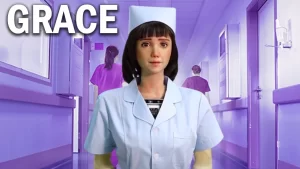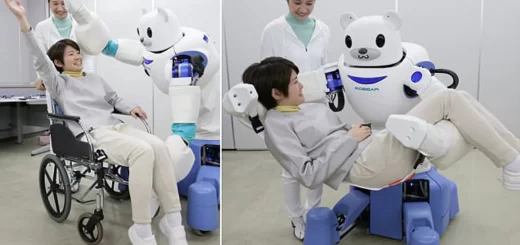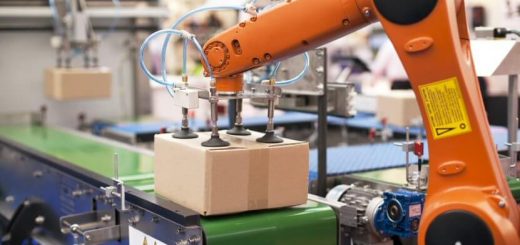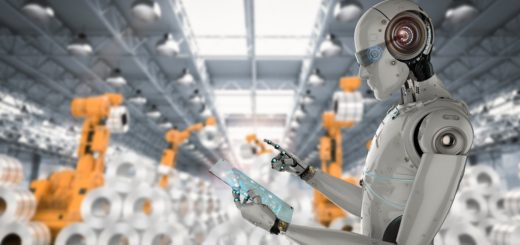Grace robot nurse advantages and disadvantages, What is Grace the robot used for?
Grace, the robot nurse, has a built-in thermal camera in her chest, allowing her to take your temperature and assess your responsiveness without physical contact. This could be especially useful during pandemics or for monitoring patients remotely.
Grace, the robot nurse
Grace is a humanoid robot, It is developed by Hanson Robotics, It is designed to assist healthcare professionals and provide emotional support to patients. It can measure vital signs, diagnose illnesses, and engage in conversation. She’s not only fluent in medical jargon but also speaks English, Mandarin, and Cantonese, making her accessible to a wider range of patients.
Grace can assist in healthcare, particularly for the elderly and those isolated. she’s equipped with advanced AI to provide support and care. Grace can offer entertainment, games, and other activities to keep patients engaged and stimulated. She can take vital signs like temperature and pulse, and assist in diagnosing patients.
Grace can engage in conversations, offer companionship, and provide emotional support. She can help with exercises and physical therapy routines. While not a medical professional, she can gather patient data and assist in preliminary assessments. Grace is designed to be a supportive companion while also providing valuable healthcare assistance. Grace can collect patient data and share it with healthcare professionals.
Grace is equipped with advanced artificial intelligence and is capable of Social Interaction, and Healthcare assistance. It’s important to note that while Grace is a remarkable piece of technology, she is not intended to replace human healthcare professionals but rather to complement their work.
Advantages of Grace robot nurse
Grace is a robot nurse, She can handle routine tasks like vitals monitoring, medication reminders, data collection, and basic assessments, reminding patients about medication, and freeing up human nurses for more complex care and patient interaction. Unlike human nurses, Grace doesn’t need breaks or sleep, offering continuous support. This can be especially beneficial for high-needs patients.
Grace‘s AI can analyze collected data to identify trends and potential health risks, aiding in preventative care and early intervention. For patients suffering from loneliness or isolation, Grace can provide emotional conversation, enhancing their well-being. With automation, some healthcare costs associated with nurse salaries and overtime might be lowered.
Grace can provide constant monitoring and personalized attention, potentially reducing falls, infections, and medication errors. By automating routine tasks and potentially improving patient outcomes, Grace could contribute to cost savings in the long run.
Grace can provide companionship and emotional support for lonely or isolated patients, improving their well-being. Grace could be deployed in areas facing healthcare worker shortages or to assist patients in remote locations.
By taking over routine tasks, Grace can alleviate the pressure on nurses, potentially reducing burnout and improving job satisfaction. Grace can provide continuous monitoring of patients, even at night or when nurses are unavailable, potentially catching critical changes early.
Grace is a humanoid robot designed specifically to assist in healthcare, particularly for the elderly and those isolated due to the COVID-19 pandemic. Grace can interact with patients, offering emotional support, reducing loneliness, and providing a sense of security. Grace can be programmed to speak multiple languages and adapt to different cultural norms, making healthcare more accessible.
Disadvantages of Grace robot nurse
The development and implementation of Grace robots require significant upfront costs, which may be prohibitive for some healthcare institutions, potentially limiting their widespread adoption. While Grace can analyze emotions, she cannot truly understand them. This limits its ability to provide nuanced emotional support like human caregivers.
Replacing human nurses with robots raises ethical concerns about job displacement, the dehumanization of healthcare, and potential biases in AI algorithms. Like any machine, Grace is susceptible to technical malfunctions and software glitches, potentially impacting patient care, it may need maintenance and updates.
Overreliance on robots for tasks traditionally performed by nurses could lead to complacency and neglect of important aspects of patient care. While Grace can perform many tasks, she lacks the critical thinking, empathy, and emotional intelligence of human nurses.
Some patients and staff may be uncomfortable or apprehensive about interacting with a robot nurse, requiring careful introduction and training. Patients may need time to adjust to and trust robot nurses. Grace cannot replace the human touch and critical thinking skills of a trained nurse.
The use of robots in healthcare raises ethical questions about patient privacy, data security, informed consent, and the potential for dehumanization. Concerns exist that robot nurses could lead to job losses for human nurses, requiring careful planning and transition strategies.
You can follow science online on YouTube from this link: Science online
You can download Science Online application on Google Play from this link: Science Online Apps on Google Play
Top trending topics about Grace robots, the healthcare robot created for coronavirus
Moxi, the AI-powered robot nurse assistant, Can Moxi robots replace human nurses?
Healthcare robotics, Nursing care robots review, types, advantages, disadvantages and uses
Moxie robot advantages, disadvantages and what does a moxie robot do?
Robotic surgery cons, pros, uses and How does robotic surgery work?
Artificial intelligence in medical field advantages & how AI medical diagnosis changes medicine
Surgical robot types, advantages, disadvantages, How is robotic surgery different from traditional
Applications of Artificial intelligence in the medical field and Healthcare
Importance of Artificial intelligence in healthcare and medicine
Domestic robot or Service Robot types, advantages and disadvantages




